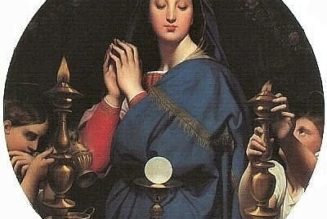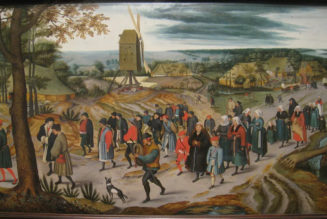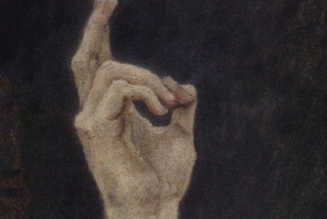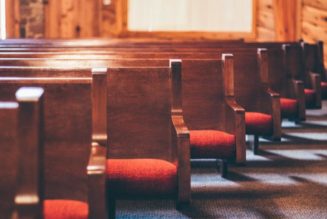
The 2018 film, All is True, starring Kenneth Branagh as William Shakespeare and Ian McKellen as Shakespeare’s patron, the Earl of Southampton, purports to be a depiction of the Bard’s final years in Stratford following his retirement from the London stage. Making no effort to remain true to the known facts of Shakespeare’s life, preferring instead to follow the path of pride and anti-Catholic prejudice, All is True reinvents him in the image of our own deplorable epoch.
This being so, and as a means of exposing the lie with the clear light of known truth, let’s examine what is actually known of Shakespeare’s last years.
Shakespeare’s last major legal transaction in London, prior to his retirement and return to Stratford, was his purchase in March 1613 of the Blackfriars Gatehouse. Clearly this large property was not bought for the Poet himself to live in. He had already shaken the London dust from his feet and had retired to New Place, the large house in Stratford he had purchased for his family from Catholic recusant friends back in 1597. Why, then, did he buy it? It wasn’t, as some of his biographers have claimed, merely an investment.
An investigation into the history of the Blackfriars Gatehouse reveals that it was “a notorious center of Catholic activities.” As its name would indicate, it had originally belonged to the Dominican Order and had been the lodging of the prior until the dissolution of the monasteries. During the reign of Mary Tudor the mansion was in the possession of Thomas Thirlby, the Catholic Bishop of Ely, who sold it to his cousin, William Blackwell, the town clerk of London. At the latter’s death in 1569, the Gatehouse was inherited by his widow, Mary, née Campion, who was related to St. Edmund Campion, the Jesuit martyr. The papist sympathies of Mary Blackwell are suggested by the fact that the Catholic Bishop of Ely was allowed to lodge at her house until his death in 1570. Further evidence of these sympathies can be seen from the fact that Mary Bannister, the sister of another Jesuit martyr, St. Robert Southwell, was a tenant at the Gatehouse for a time, and from the fact that Katherine Carus, a kinswoman of the Lancashire Hoghtons and the widow of a defiantly recusant judge, had died there “in all her pride and popery.”
In 1585 Mary Blackwell was accused of recusancy and, in the following year, a government informer reported his suspicions that the house had become a center for secret Catholic activity. It seems, therefore, that the Gatehouse was a hub of recusant activity by the mid-1580s, around the time the Shakespeare first arrived in London.
In 1590 the Gatehouse passed into the possession of Mathias Bacon, Mary Blackwell’s grandson, who leased it to a Catholic, John Fortescue, whose father, Sir Anthony Fortescue, had been implicated in a conspiracy against Elizabeth in 1562, and whose mother was related to Cardinal Pole. John Fortescue married Ellen, the daughter of Ralph Henslowe, a Catholic recusant from Hampshire, who was a kinsman of the Earl of Southampton, the Catholic nobleman who was Shakespeare’s patron. In 1591, two priests, Anthony Tyrrell and John Ballard, reported that they had delivered “such stuff as we brought from Rome” to John and Ellen Fortescue, and in the same year it was recorded that “Fennell the priest does use to come very much to Mr John Fortescue’s house.” In 1598, acting on a report that the Gatehouse was a hive of recusant activity which had “many places of secret conveyance in it” and “secret passages towards the water,” i.e., towards the river Thames from whence priests could make their escape, the authorities raided the house. John Fortescue was absent during the search but his wife and daughters were interrogated, admitting that they were recusants but refusing to confess that they had hidden priests in the house. The Jesuit, Oswald Greenway, recorded in his autobiography that he had paid a surreptitious visit to the Gatehouse on the day after the raid, being informed that there had been priests in the house during the search but that their hiding places had not been discovered.
Fortescue, his wife, and their two daughters, were all imprisoned after the raid but seem to have recommenced their recusant activity following their release. In 1605, the Jesuit, John Gerard, asked Ellen Fortescue, in her husband’s absence, if he could use the Gatehouse as a “safe-house” in which Catesby, Percy, Winter and other “gunpowder plotters” could meet in secret. Wisely and prudently, she declined to admit the conspirators, claiming that she did not approve of Catesby. Her prudence on this occasion probably saved her life, and the lives of her family. A few months later, after the plot had been discovered, Father Gerard, now the most wanted man in England, appeared in desperation at the Gatehouse, wearing a false beard and false hair as a disguise, and asking for shelter, stating that he did not know where else to hide. Unlike many of his Jesuit confreres, Father Gerard managed to escape the clutches of his pursuers, slipping out of the country in disguise. Shortly afterwards, John Fortescue also went into exile, harried out of his home and his country by the incessant persecution.
Little is known of the history of the Gatehouse in the few years from the time that the Fortescues went into exile and the time that Shakespeare purchased it from its latest owner, Henry Walker, but as late as 1610 it was reported in Naples that it was the base for Jesuits plotting to “send the King an embroidered doublet and hose, which are poisoned and will be death to the wearer.” As much as such a statement can be dismissed as the product of the idle fantasies of embittered exiles or anti-Catholic spies, it is apparent nonetheless that Shakespeare had chosen to purchase one of the most notorious Catholic houses in the whole of London. This in itself is curious enough but is not by any means the end of the story.
Shakespeare chose to lease the Gatehouse to John Robinson, son of a gentleman of the same name who was an active Catholic. It was reported, in 1599, that John Robinson senior had sheltered the priest, Richard Dudley, in his home. He had two sons, Edward and John, the former of whom entered the English College at Rome and became a priest and the latter of whom became Shakespeare’s tenant. It is clear, therefore, that Shakespeare knew that in leasing the Gatehouse to John Robinson he was leaving it in the possession of a recusant Catholic. In consequence, and as Ian Wilson surmised in Shakespeare: The Evidence, Robinson was “not so much Shakespeare’s tenant in the Gatehouse, as his appointed guardian of one of London’s best places of refuge for Catholic priests.” Furthermore, John Robinson was not merely a tenant but was quite obviously a valued friend. He visited Shakespeare in Stratford during the Poet’s retirement and was seemingly the only one of the Bard’s London friends who was present during his final illness, signing his will as a witness.
These are the facts that the makers of All is True studiously ignore.
Although very little is known of Shakespeare’s last years in Stratford, the fact that “he died a papist,” as was recorded by the 17th-century Anglican clergyman, Richard Davies, is suggested by the evidence of Shakespeare’s will. Apart from the reference in the will to the Blackfriars Gatehouse, “wherein one John Robinson dwelleth scituat,” it is noteworthy that Shakespeare bequeathed his property to his daughter, Susanna, who had been fined for her Catholic recusancy in 1606.
Those of Shakespeare’s friends who were beneficiaries of his will included his old friend, Hamnet Sadler, who was godfather to Shakespeare’s twins and who was, like Susanna, listed as a recusant in 1606. Another beneficiary was Thomas Combe, a staunch and defiant Catholic, who would be listed as a recusant in 1621, and again, 20 years later, in 1641. The Catholic brothers, John and Anthony Nash, longstanding friends of the Poet, were also left money in the will.
William Reynolds, another beneficiary of Shakespeare’s will, was sent to Warwick Jail for his recusancy in the autumn of 1613, languishing there with Shakespeare’s old Henley Street neighbor, George Badger. On Oct. 2, 1613, Badger wrote to the Chief Clerk of Stratford, revealing that another Stratford Catholic, William Slaughter, who had been named with John Shakespeare, the poet’s father, on the recusancy list of 1592, had appeared at the jail “to release William Reynolds of Stratford” on security. This episode is of particular interest because it shows that some of Shakespeare’s dearest friends in Stratford, with whom he had remained on the closest terms during the final years of his life, were being imprisoned for their Catholic faith. It is also tempting to conjecture, though of course it cannot be proved, that William Reynolds had actually been bailed out with Shakespeare’s money, with William Slaughter merely acting as an agent. The circumstantial evidence at least makes such an apparently fanciful supposition a possibility. We know that Shakespeare, as the owner of the second largest house in Stratford, was one of the wealthiest people in the neighborhood; we know that he had already put his money where his faith was in the purchasing of the Blackfriars Gatehouse only six months earlier; and we know that William Reynolds was one of his closest friends, being one of a mere handful of associates who were listed in his will. Such a supposition may indeed be fanciful but it is also eminently plausible, unlike the nonsense presented in All is True.









